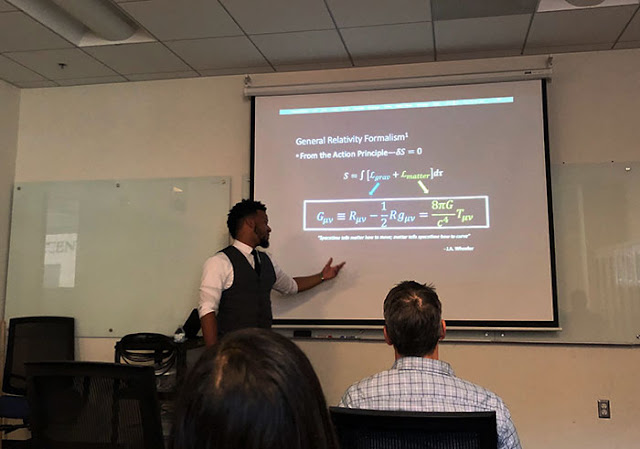In this post we will make some comments on a masters degree thesis defense presentation and a physics colloquium presentation on net zero carbon energy systems while we wait for the storms to move through the southland.
The thesis, "Relativistic Tidal Deformations of Hybrid Stars" was an ambitious project to first of all work through how gravitational effects that occur during the merger to binary stars, which give rise to gravitational waves, which can be detected here on Earth, also carry information caused by the tidal deformation of the stars. The second part of the thesis project was to work through how these deformations carry information about how "stiff" the stars are and what the equation of state is for the material that make up the star. For instance, we think of neutron stars as being made up of neutrons, which is sort of true, but the more complete and complicated answer is that the equation of state includes probably a collection of quarks and more. So, the decoding of the gravitational waves tells us more than just the masses of the merging stars, but also allows one to look inside the star and gain some understanding of what the stars are made of in a detail that was previously only guessed at.
So, I could sort of follow the general relativity portion of the thesis, but became quite lost when the equation of state and QCD discussion came up. Anyway, the student presented a good defense and answered all the questions from the floor. Congratulations to the new Master, Bryen!
 |
| CSULB Masters candidate, Bryen defends " Relativistic Tidal Deformations of Hybrid Stars" |
Next up was the UCI Physics Colloquium where Professor Steve Davis talked about "Net-zero emissions energy systems." As the amount of CO2 in the atmosphere continues to increase and the effects and understanding thereof continue to evolve, means of controlling the amount of CO2 emitted by energy systems is being seriously studied. This presentation looked at which portions of the energy services sector of the economy can more easily control CO2 emissions and which sectors will have a more difficult time.
 |
| UCI Professor Steve Davis at colloquium presentation on "Net-zero emissions energy systems." |
For instance, Professor Davis, in a study published in Science, identified six major energy services sectors that will face a hard time moving away from liquid fuels. Those sectors, as seen in the chart below are Load Following Electricity, Aviation, Long Distance Heavy Transportation, Cement, and Iron and Steel Production. Other sectors residential and commercial users of electricity and automobile transportation will be more easily decarbonized.
 |
| Decarbonization of some energy services is easy and others are hard (Source: Steve Davis, et al, Science, 360, 29 June 2018) |
Professor Davis, et al, also considered conceptual integrated systems to better support energy services decarbonization. For instance, in addition to various energy efficiency measures, new sources of carbon neutral power generation are being considered as are means of storing and sequestering CO2 and not releasing it into the atmosphere. One of the big problems that an integrated system must solve is how to better incorporate variable renewable power generation, like wind and solar, so that power is always available to the connected load, even when the wind stops blowing in some areas or the sun is blocked by clouds and weather in other areas. Also various synthetic liquid fuels, which could be carbon neutral, are being considered and evaluation. You can see various flows of chemicals in this integrated system that includes hydrogen, ammonia and other synthetic, carbon neutral hydrocarbons This kind of study helps identify where research is needed in order to meet the final goal, of not going without electricity, but of making it more carbon neutral.
 |
| Conceptual integrated system diagram providing energy services without adding CO2 (Source: Steve Davis, et al, Science, 360, 29 June 2018) |
The problem of storing electricity was discussed and the need for more effective energy storage systems is a key research program. This need resonated very much with me in that I had spent many working years on helping to develop alternative forms of power generation and trying to develop energy storage systems.
The problem with current electricity storage systems, like Li-ion battery systems, in most electric vehicles now, is that they are expensive and the energy storage density, megajoules or kilowatt-hours, per kilogram weight, is very small compared to liquid fuels. In the chart below you can see that the typical battery system stores about 1 MJ / kg, while the equivalent storage basis for liquid fuels can be 42-45 MJ / kg. This is why making long haul trucks or airplanes that operate on stored electricity very ineffective.
 |
| Storing electricity is hard as seen in energy density comparison of Li-ion battery and carbon fuels (Source: Steve Davis) |
So, it was interesting to hear about some of the issues and systems being considered. Thanks for an informative presentation, Professor Davis!
Finally, all of my Facebook friends, that is my friends who use Facebook, tell me of the sad fate of Grumpy Cat, who just passed away. You have probably seen pictures of that face, with the characteristic grumpy look on it, but maybe didn't really pay much attention. So, I passed on the news to Astronomer Assistant, Willow, to see what all of this meant to her. Well, as you can see, she didn't seem to have any recognition of who Grumpy Cat was or even what I said at all. Nonetheless, the news of Grumpy Cats demise was a sad day for many Facebook followers!
 | |
|
Until next time,
Resident Astronomer George
Be sure to check out over 300 other blog posts on similar topics
If you are interested in things astronomical or in astrophysics and cosmology
Check out this blog at www.palmiaobservatory.com

No comments:
Post a Comment